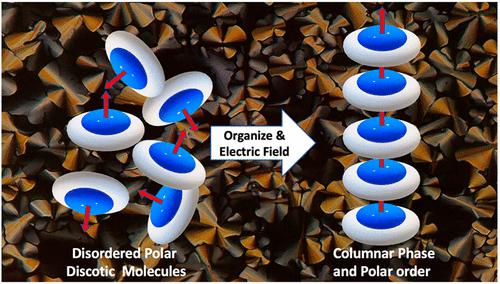当前位置:
X-MOL 学术
›
Acc. Chem. Res.
›
论文详情
Our official English website, www.x-mol.net, welcomes your
feedback! (Note: you will need to create a separate account there.)
Molecular Shape and Polar Order in Columnar Liquid Crystals
Accounts of Chemical Research ( IF 16.4 ) Pub Date : 2022-10-04 , DOI: 10.1021/acs.accounts.2c00452 Timothy M Swager 1
Accounts of Chemical Research ( IF 16.4 ) Pub Date : 2022-10-04 , DOI: 10.1021/acs.accounts.2c00452 Timothy M Swager 1
Affiliation

|
Bottom-up materials design by the conceiving of new molecular building blocks is powerful and chemists are uniquely qualified to innovate. Liquid crystals (LCs) and related soft crystals, collectively called mesophases, naturally create materials with dynamic properties. The thermotropic LC state has a liquid-like intermolecular disorder, but the cooperative nature of these materials facilitates a long-range directional order (alignment) that couples strongly to applied electric/magnetic fields and interfaces. Thermotropic LCs are held together by mesogen cores, which are often unsaturated with anisotropic polarizability, and are appended with flexible (often n-alkane) side chains. Thermal excitation of the side chains produces large amplitude motions that drive a melting transition, and the anisotropic attractions between mesogenic cores produce a directional organization that produces the LC order. LCs are liquids as defined by thermodynamics and may not contain three-dimensional (3D) organization. However, in many cases there are 3D ordered phases below the melting temperatures, which are soft (deformable) plastic materials. Unconventional mesogens offer opportunities to create responsive molecular assemblies with optical, electronic, or magnetic activity. I will detail in this account my efforts to control these dynamic states with the goal of creating polar organizations in columnar LCs. The use of molecular shape, dative bonding, and dynamic correlations between molecules in fluid/plastic phases will be highlighted and how applied electric fields can polarize select materials.
中文翻译:

柱状液晶中的分子形状和极性顺序
通过构思新的分子结构单元进行自下而上的材料设计是非常强大的,化学家具有独特的创新能力。液晶 (LC) 和相关的软晶体统称为中间相,自然会产生具有动态特性的材料。热致 LC 状态具有类似液体的分子间紊乱,但这些材料的协同性质促进了与施加的电场/磁场和界面强烈耦合的长程定向有序(对齐)。热致液晶由介晶核结合在一起,介晶核通常是不饱和的,具有各向异性极化率,并且附加有柔性(通常是n-烷烃)侧链。侧链的热激发产生驱动熔化转变的大幅度运动,介晶核之间的各向异性吸引力产生产生 LC 顺序的定向组织。LC 是热力学定义的液体,可能不包含三维 (3D) 组织。然而,在许多情况下,在熔化温度以下存在 3D 有序相,它们是软(可变形)塑料材料。非常规介晶提供了创建具有光学、电子或磁活性的响应性分子组装体的机会。我将在这篇文章中详细介绍我为控制这些动态状态所做的努力,目的是在柱状 LC 中创建极性组织。使用分子形状,配位键合,
更新日期:2022-10-04
中文翻译:

柱状液晶中的分子形状和极性顺序
通过构思新的分子结构单元进行自下而上的材料设计是非常强大的,化学家具有独特的创新能力。液晶 (LC) 和相关的软晶体统称为中间相,自然会产生具有动态特性的材料。热致 LC 状态具有类似液体的分子间紊乱,但这些材料的协同性质促进了与施加的电场/磁场和界面强烈耦合的长程定向有序(对齐)。热致液晶由介晶核结合在一起,介晶核通常是不饱和的,具有各向异性极化率,并且附加有柔性(通常是n-烷烃)侧链。侧链的热激发产生驱动熔化转变的大幅度运动,介晶核之间的各向异性吸引力产生产生 LC 顺序的定向组织。LC 是热力学定义的液体,可能不包含三维 (3D) 组织。然而,在许多情况下,在熔化温度以下存在 3D 有序相,它们是软(可变形)塑料材料。非常规介晶提供了创建具有光学、电子或磁活性的响应性分子组装体的机会。我将在这篇文章中详细介绍我为控制这些动态状态所做的努力,目的是在柱状 LC 中创建极性组织。使用分子形状,配位键合,











































 京公网安备 11010802027423号
京公网安备 11010802027423号